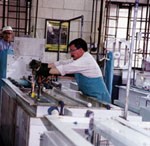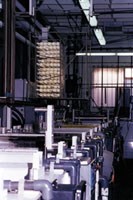Decorative Plating at Quaker City
Quaker City Plating provides high- end, high-value decorative plating on plastic and metal substrates. Although its customers have always been satisfied, QCP wasn't. It wanted a better preplate system for its plastic plating processes, and it found what it was looking for...
Whether you are plating plumbing fixtures, fasteners or printed circuit boards, plastic hubcaps, aluminum wheels or diecastings, the most important processing tanks are not the chromium, zinc, gold or nickel tanks but the preplate tanks where the parts are cleaned and prepped for plating. And no company knows this better than Quaker City Plating (QCP), Whittier, CA, where more than 100 finishes are plated on aluminum, brass, steel, zinc diecast and plastic substrates.
Although QCP fits the description of your basic plating job shop, it qualifies itself as a specialty plating house. "Our niche is high quality and high value," stated Mr. Chuck Wolitski, general manager for the company.
The company divides itself into three segments (all of which include metal and plastics plating): aircraft industry; high-volume commercial plating; and specialty finish commercial, which includes plumbing and hardware. The company also does a lot of after market motorcycle parts plating, which is a substantial industry in southern California. "Our decorative plating business has really grown in the past year," noted Mr. Wolitski. "We do a lot of high end work for aircraft manufacturers. Gold plated accents and switch panels are standard in many of the aircraft. Some of these plane interiors are quite ornate. Of course, today, there is quite a bit of customized work in the plumbing industry too," he added.
As Mr. Wolitski explained, many customers are not buying plumbing fixtures "off the shelf" at the local hardware store. Instead, customers go to a local dealer representative where they can customize their bathroom and kitchen fixtures, going so far as to match up satin nickel-plated faucets with black nickel-plated handles or gold plated handles and antique brass plated faucets. It's the customer's choice, and QCP provides this special order plating.
High value orders such as these demand high quality plating, and QCP is willing to "go the extra mile," as Mr. Wolitski puts it, to satisfy its customers. However, the extra mile now includes fewer preplate steps prior to decorative plastics plating than it once did.
The first plastics preplate process QCP installed followed a direct metalization processing sequence: alkaline clean; etch; neutralize; catalyze; accelerator; and direct metalization. Although the process adequately cleaned and prepped the parts, QCP always kept its eye open for something that might clean a little better, cost a bit less or work a tad harder.
"Cost was a driving factor in our decision to install the Ionogen plastic preplate process from Enthone; however, we were not going to install any process that infringed on part quality," insisted Mr. Wolitski. After evaluating the process, QCP was convinced that this was the plastic preplate process for all its decorative plastic plating work.
The process allows QCP to reduce processing steps by eliminating the neutralization step, because there is chromium (hexavalent) in the activator. Normally one would need the neutralization step to reduce the hexavalent chromium to trivalent chromium; however, in the new process the parts are transported directly in the accelerator, which contains chromium. In the accelerator step, both chromium and palladium are reduced, eliminating the need for the neutralization step. "There is chromium in the activator, so it allows a large amount of chromium dragin from the etch tank without contaminating or damaging the activator bath. It is a very robust process."
In particular, QCP was concerned about a part with a blind hole and an insert. The blind hole trapped an appreciable amount of chrome from the chromic acid etch step and dragged it into the activator bath. The component was part of a set that had to be run together through the subsequent trivalent chromium plating process in order to maintain color consistency. "This is a high profile job that I would not eliminate. But we had dumped out three or four of the previous activator baths, at $3,000 to $4,000 a bath, running these parts," stated Mr. Wolitski. "We needed to resolve this problem, quickly."
The basic preplate process layout for the newly installed system has a chromic/sulfuric acid etch; heated rinse; two ambient rinses (all counterflow); activator; triple counterflow rinses; accelerator; and the final electroless nickel plating step followed by a triple counterflow rinse. The electroless nickel is applied to 10-15 millionths of an inch. Time in tank and temperature for each step varies according to product and the type of plastic running through the system.
The final electroless nickel step differs from the standard electroless copper plating step used in most decorative plating preplate systems. The electroless copper one finds in many preplate systems is probably a hold over from automotivespecifications, however more industries are realizing that there are not any major advantages in electroless copper versus electroless nickel. An advantage to using electroless nickel for the plater is in cost and safety because he does not have to handle the formaldehyde necessary for plating electroless copper or treat the copper waste. Also, according to Mr. Wolitski, electroless nickel baths are much easier to control because they are more stable since there is less frequency of plate out than with electroless copper.
Presently, preplating is set up as a single hoist line in one of 12 buildings used by QCP. Parts are racked, run through the process, unracked, transported to a decorative plating line (gold, nickel chromium, etc.), reracked, plated and then unracked and packed. "We are looking into developing one line whereby we could do all the preplate and nickel chromium plating in a continuous line," explained Mr. Wolitski. "This line would have 1,000-gal tanks as opposed to the 100-gal tanks we now have on the preplate line. Also, we would save a tremendous amount of money on labor, since we would only need to rack the parts once."
QCP would retain its present decorative nickel chromium plating process, Envirochrome, from MacDermid, Inc., however it would combine the preplate process with the nickel chromium plating line. This would allow for continuous plating on this one line, a cost saving maneuver in both labor and time since much of the plating at QCP runs through this line.
"We started using trivalent chromium about 15 years ago," noted Mr. Wolitski. "We wanted to eliminate any environmental and worker risks related to hexavalent chromium."
The decorative chromium plating process is a sulfate-based electrolyte. No chloride evolves at the anodes; and, therefore, there is no corrosive effect. QCP uses EC10 anodes in the plating bath. These are inert anodes plated with special catalytic coatings used in direct contact with the plating solution. A protective mesh covers the anodes.
The decorative chromium plating bath operates at 120F and a pH of 3.7 to 3.8. Current density runs at 60 asf. Deposition is 0.1 micron per minute at 60-80 amp/sq ft, with leveling after approximately 3 min.
Plastic parts slated for decorative precious metal finishes, such as gold, silver or even brass or bronze, are taken off line after preplate and transported to the proper line.
"We have an excellent reputation in that we do not lose customers," noted Mr. Wolitski. "Our current accounts grow because we provide the best service possible. Stability is a big key to QCP's reputation and continued growth." Although QCP only started plating on plastics a year ago, it has become a force to reckon with in southern California.
To learn more visit Enthone Inc. and MacDermid Enthone.
Related Content
Successful South African Plater Beating the Odds
Remaining focused on quality and reliability, Team Plating Works stays profitable in a volatile and challenging economy.
Read MoreTroubleshooting Alkaline Zinc
One of the most common problems that can arise when plating with alkaline zinc is an imbalance of brightener in the solution. In this helpful Ask the Expert article, Chad Murphy of Columbia Chemical discusses how different zinc metal concentrations and brightener concentrations can impact efficiency.
Read MoreA Chromium Plating Overview
An overview of decorative and hard chromium electroplating processes.
Read MoreInnovation in Plating on Plastic
Plating on advanced plastics solution offers improved adhesion, temperature resistance and cost savings.
Read MoreRead Next
A ‘Clean’ Agenda Offers Unique Presentations in Chicago
The 2024 Parts Cleaning Conference, co-located with the International Manufacturing Technology Show, includes presentations by several speakers who are new to the conference and topics that have not been covered in past editions of this event.
Read MoreDelivering Increased Benefits to Greenhouse Films
Baystar's Borstar technology is helping customers deliver better, more reliable production methods to greenhouse agriculture.
Read MoreEducation Bringing Cleaning to Machining
Debuting new speakers and cleaning technology content during this half-day workshop co-located with IMTS 2024.
Read More
















.jpg;maxWidth=300;quality=90)







